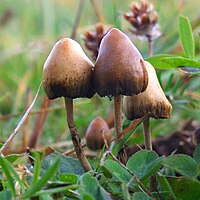
Photo from wikipedia
Therapeutic use of psilocybin has become a focus of recent international research, with preliminary data showing promise to address a range of treatment-resistant mental health conditions. However, use of psilocybin… Click to show full abstract
Therapeutic use of psilocybin has become a focus of recent international research, with preliminary data showing promise to address a range of treatment-resistant mental health conditions. However, use of psilocybin as a healing entheogen has a long history through traditional consumption of mushrooms from the genus Psilocybe. The forthcoming adoption of new psilocybin-assisted therapeutic practices necessitates identification of preferred sources of psilocybin; consequently, comprehensive understanding of psilocybin-containing fungi is fundamental to consumer safety. Here we examine psilocybin producing fungi, discuss their biology, diversity, and ethnomycological uses. We also review recent work focused on elucidation of psilocybin biosynthetic production pathways, especially those from the genus Psilocybe, and their evolutionary history. Current research on psilocybin therapies is discussed, and recommendations for necessary future mycological research are outlined.
Journal Title: Fungal biology
Year Published: 2022
Link to full text (if available)
Share on Social Media: Sign Up to like & get
recommendations!